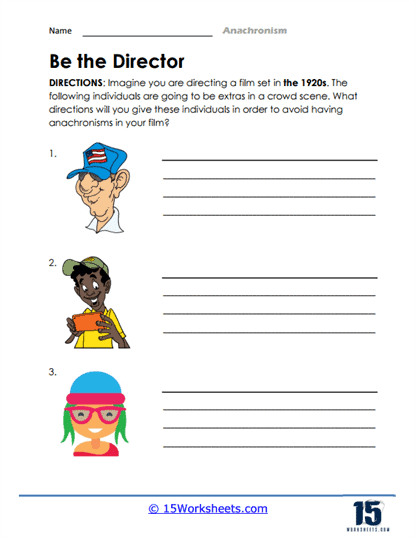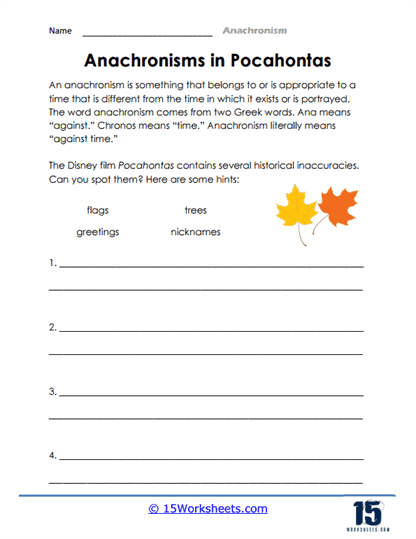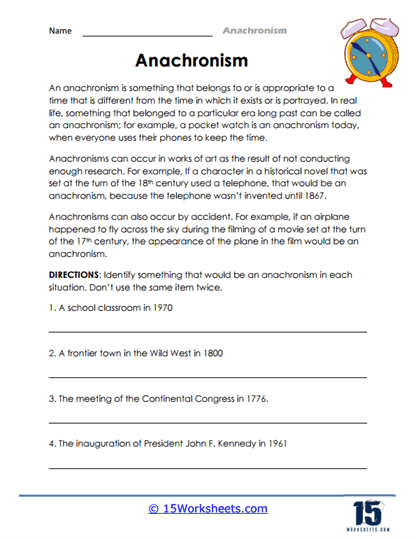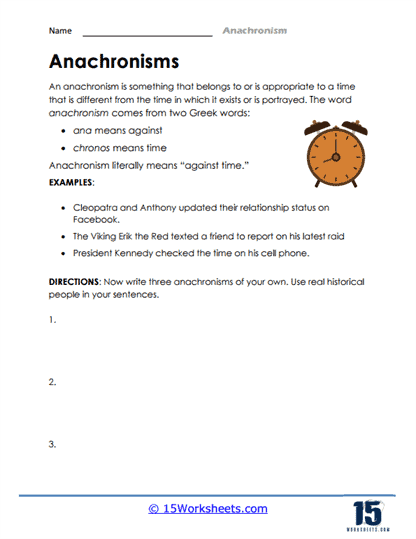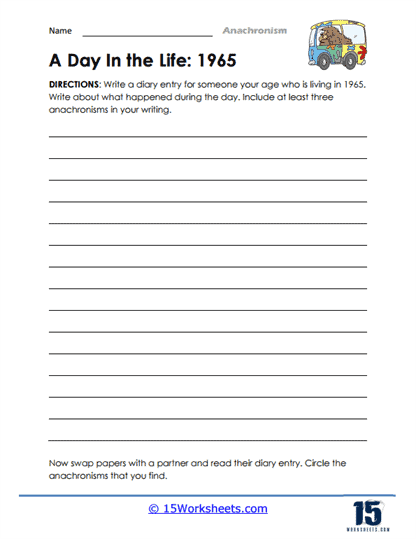Anachronism Worksheets
All About These 15 Worksheets
Anachronism, the introduction of something into a time period where it doesn’t belong, is a captivating concept that invites students to explore history, culture, and storytelling from a unique perspective. Understanding anachronisms not only enhances historical and literary comprehension but also fosters critical thinking and creativity. In an era where knowledge of the past and the ability to think critically are essential, students must develop the skills to recognize and interpret anachronisms.
To empower students with the ability to engage with anachronisms effectively, we proudly present a collection of 15 worksheets on Anachronism. These worksheets are thoughtfully designed to provide students with structured and engaging opportunities to explore and understand anachronism and its significance.
These activities will help you understand when something from the past doesn’t fit with the time it is shown in. An anachronism is when something, like an object, a word, or a person, is in a story or movie but doesn’t belong in that time period.
In these worksheets, you’ll see examples of things that are out of place in a specific time. For example, you might see a story set in ancient times, but someone is talking on a cellphone or wearing modern clothes. These are anachronisms because they don’t match the time period of the story.
The goal of anachronism worksheets is to help you notice and think about how things should be consistent with the time they are shown in. By recognizing anachronisms, you can have a better understanding of history and how things have changed over time.
Teachers use these worksheets to make learning about history more interesting and to help students develop a sense of time and context. It’s like a detective game where you spot the things that don’t quite belong!
Why Do Authors Use Anachronism As A Literary Device?
There are many different reasons that authors may use this technique. Here are the four most common examples:
Creative Expression
Anachronism allows authors to incorporate elements from different time periods into their stories, creating a unique and imaginative blend. By intentionally including anachronistic elements, authors can add an element of surprise or playfulness to their narratives. For instance, in the book “The Lightning Thief” by Rick Riordan, Greek gods and mythical creatures are portrayed in modern-day settings, combining ancient mythology with contemporary society to create an exciting and unexpected adventure.
Satire and Commentary
Anachronism can be used as a tool for social commentary or satire. By placing objects, ideas, or characters from different time periods together, authors can highlight the absurdity or critique certain aspects of society. In Mark Twain’s novel “A Connecticut Yankee in King Arthur’s Court,” a 19th-century engineer time-travels to King Arthur’s era and introduces anachronistic inventions and knowledge, which satirizes and questions the medieval society’s customs and beliefs.
Subverting Expectations
Anachronism can be employed to challenge historical accuracy and disrupt conventional narratives. Authors sometimes use anachronistic elements to surprise readers and challenge their assumptions about a particular time period. In the film “Shakespeare in Love,” anachronisms such as modern phrases and references are intentionally included to create a playful and fresh take on William Shakespeare’s life and works.
Establishing Universality
Anachronism can help make a story or theme more relatable and timeless by connecting it to different eras. By using anachronistic elements, authors can emphasize the universal aspects of human experiences that transcend time. In the play “Romeo and Juliet” by William Shakespeare, although set in the 14th century, the themes of love, conflict, and generational divide resonate with audiences across different time periods, making the story relevant and relatable to contemporary readers and viewers.
The Importance of Understanding Anachronism For Students
Understanding anachronism and its various forms is of great importance for several reasons:
- Historical Context: Recognizing anachronisms is fundamental for understanding historical texts, artifacts, and representations accurately.
- Cultural Awareness: Understanding anachronisms in language, customs, and technology can deepen cultural awareness and sensitivity.
- Critical Thinking: Analyzing anachronisms in literature and media encourages critical thinking and reflection on the implications of misplaced elements.
- Creative Expression: Employing anachronism creatively can lead to innovative and thought-provoking storytelling and artistic endeavors.
Benefits Of These Anachronism Worksheets
This comprehensive collection of Anachronism worksheets offers numerous advantages for students:
- Structured Learning: The worksheets are thoughtfully organized to provide students with a structured learning experience. They progress from basic anachronism concepts to more complex literary and historical applications, ensuring a comprehensive understanding.
- Engaging Activities: Each worksheet incorporates fun and interactive activities, including analyzing historical documents, interpreting anachronistic artwork, and creating anachronistic stories. These activities make learning about anachronism enjoyable, keeping students motivated and interested.
- Versatility: These worksheets can be used in various educational settings, including history classes, literature courses, and creative writing workshops. They are adaptable to students of different ages and proficiency levels.
- Enhanced Critical Thinking: Proficiency in recognizing and interpreting anachronisms cultivates sharper critical thinking skills, empowering students to engage with historical and literary materials more deeply.
- Creative Expression: Understanding how to use anachronism creatively allows students to explore new dimensions of storytelling and artistic expression.
This collection of Anachronism worksheets is a valuable resource for educators and parents committed to fostering historical understanding, critical thinking, and creative expression in students. Proficiency in recognizing and interpreting anachronisms equips individuals to engage with history, literature, and art more deeply, promoting a richer understanding of our world and its cultural and historical nuances.
This collection is an investment in their future success, ensuring they have the skills to excel academically and thrive in their personal and creative endeavors. Explore these Anachronism worksheets today, and watch your students unravel the mysteries of time and storytelling with insight and creativity.





